-
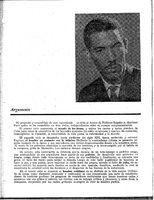 CFNC program book: Rogelio Martínez Furé
CFNC program book: Rogelio Martínez Furé Martínez Furé and other scholars who went on to become major figures in folklore and Afrocubanist studies studied with León in a series of seminars on folklore and ethnographic research (Moore 2006). Rogelio Martínez Furé founded the ensemble with the Mexican choreographer Rodolfo Reyes, who soon departed. Ramiro Guerra, who founded the Modern Dance Ensemble of Cuba, did some work with the CFNC and was apparently influential in the techniques, but likewise did not remain with the group. Roberto Espinosa Amor and later Manolo Micler were the main choreographers during the first three decades.
-
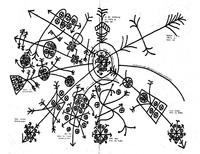 Abakuá concert program cover
Abakuá concert program cover This is the reproduction of the cover of a concert program for abakuá music. The original concert was part of a series produced by Argelier León between 1959 and 1962. This one was of Abakuá music and the program notes include an essay about abakuá music and a transcription of some of the songs. The cover shows the ritual writing, a set of graphic symbols denoting important elements of the group's history and cosmology. I received a copy of the program at an event at Casa de Africa in 2011.
-
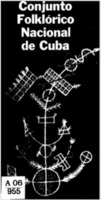 1977 Report on the CFNC
1977 Report on the CFNC
-
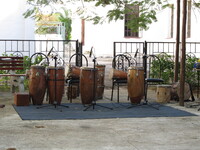 Drums on stage (2011).
Drums on stage (2011). Folkloric shows are created around the music of many different styles of Afrocuban religious and popular traditions. The basic ensemble consists of three conga drums (tumbadoras), a pair of claves, and a wood block (or bamboo). There are also sets of drums that are specific to particular types of music such as the batá drums of Regla de Ocha (Santeria) or the biankomo of Abakuá folklore. In the past decades the tradition of rumba has expanded musically and most groups that play rumba supplement the basic ensemble with other drums. Here you see cajaones supplementing the use of tumbadoras.
-
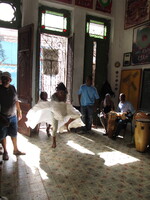 Audition III
Audition III Yaneisi auditioning for Oba Ilú at the rehearsal space they share with Cabildo Quisicuaba in the Havana neighborhood, Los Sitios.
-
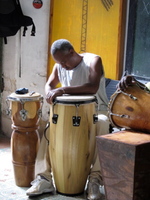 Tuning the drum (2011).
Tuning the drum (2011). Silvio tuning the drum.
-
 Abakuá music II (2011).
Abakuá music II (2011). Men from Oba Ilú play abakuá music. Amauris (on biapa, front left), Silvio (on cuchiyerema, back), Librado (on bonkó enchemiya, center), Penton (on ekon, back right), Dionisio (eroapa, right out of frame).
-
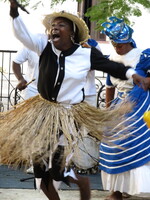 Teresa as Elegua (2011).
Teresa as Elegua (2011). Teresa of Oba Ilú dancing as Elegua in a folkloric show at the Hotel San Alejandro in Mariano, Havana.
-
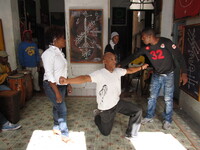 Rehearsing congo folklore, II (2011).
Rehearsing congo folklore, II (2011). Yeny, Miguel, Amauris rehearsing with Oba Ilú (2011).
-
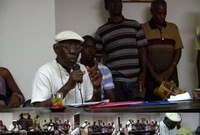 Hernández speaking at the Cuban Institute of Anthropology (2011).
Hernández speaking at the Cuban Institute of Anthropology (2011). Gregorio Hernández speaking about abakuá folklore at a conference of the Cuban Institute of Anthropology with members of Oba Ilú.
-
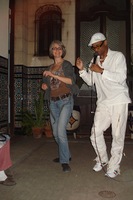 EK Batiuk on stage at a peña in Havana (2011).
EK Batiuk on stage at a peña in Havana (2011).
-
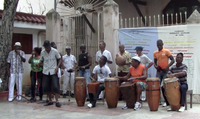 Ven Tu (2011)
Ven Tu (2011) Oba Ilú at a "ven tu" at Sábado de la Rumba. A "ven tu" is a kind of open mic even in which a band will host an event
-
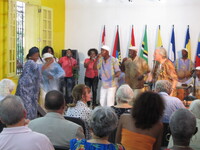 Oba Ilú at Casa de Alba, I (2011).
Oba Ilú at Casa de Alba, I (2011). Oba Ilú played many official events. This photo was taken at one such event at the Casa de Alba, an institute devoted to the trade alliance formed between Cuba and other Caribbean and South American countries.
-
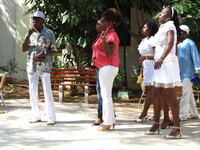 Oba Ilú at Hotel Alejandro, II (2011).
Oba Ilú at Hotel Alejandro, II (2011). Oba Ilú performs a rich and varied program including Afrocuban folklore and popular traditions. This is the opening number of the second half of the program introducing the rumba segments with music form the coros de clave. Gregorio Hernández leads the singers with Yeny and Teresa at the front.
-
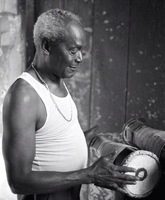 Jesús Pérez
Jesús Pérez Jesús Pérez was a musician in the traditions of regla de ocha and rumba. He played for Danza Contemporanea as Cuban modern dance developed in the years following the Revolution. He made recordings of Afrocuban religious music.
-
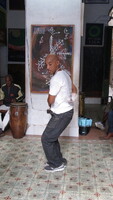 Miguel Martínez (b. 1964).
Miguel Martínez (b. 1964). Miguel rehearsing columbia with Oba Ilú (2011).
-
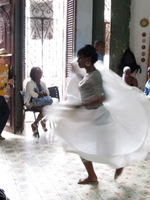 Audition I (2011)
Audition I (2011)
-
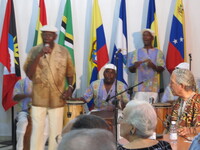 Oba Ilú at Casa de Alba (2011).
Oba Ilú at Casa de Alba (2011).
-
 Abakuá music
Abakuá music
-
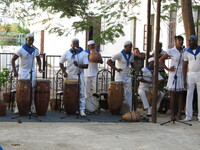 Oba Ilú at Hotel San Alejandro (2011).
Oba Ilú at Hotel San Alejandro (2011).
-
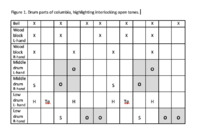 Columbia rhythms
Columbia rhythms transcription of percussion rhythms
-
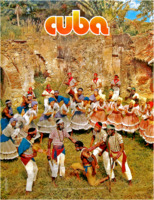 "Cuba" Congo Poster CFNC
"Cuba" Congo Poster CFNC
-
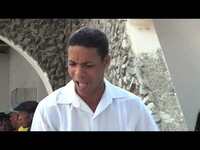 Columbia, Conjunto Folklorico Nacional de Cuba, May 2011.
Columbia, Conjunto Folklorico Nacional de Cuba, May 2011.
-
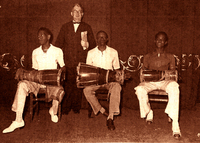 Ortiz (standing), Morales, Roche, Pérez
Ortiz (standing), Morales, Roche, Pérez
-
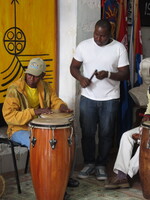 Percussionists (2011).
Percussionists (2011). Kiki on clave, Cocominas on tumbadora, Silvio (l. out of frame) on guagua.
 CFNC program book: Rogelio Martínez Furé Martínez Furé and other scholars who went on to become major figures in folklore and Afrocubanist studies studied with León in a series of seminars on folklore and ethnographic research (Moore 2006). Rogelio Martínez Furé founded the ensemble with the Mexican choreographer Rodolfo Reyes, who soon departed. Ramiro Guerra, who founded the Modern Dance Ensemble of Cuba, did some work with the CFNC and was apparently influential in the techniques, but likewise did not remain with the group. Roberto Espinosa Amor and later Manolo Micler were the main choreographers during the first three decades.
CFNC program book: Rogelio Martínez Furé Martínez Furé and other scholars who went on to become major figures in folklore and Afrocubanist studies studied with León in a series of seminars on folklore and ethnographic research (Moore 2006). Rogelio Martínez Furé founded the ensemble with the Mexican choreographer Rodolfo Reyes, who soon departed. Ramiro Guerra, who founded the Modern Dance Ensemble of Cuba, did some work with the CFNC and was apparently influential in the techniques, but likewise did not remain with the group. Roberto Espinosa Amor and later Manolo Micler were the main choreographers during the first three decades. Abakuá concert program cover This is the reproduction of the cover of a concert program for abakuá music. The original concert was part of a series produced by Argelier León between 1959 and 1962. This one was of Abakuá music and the program notes include an essay about abakuá music and a transcription of some of the songs. The cover shows the ritual writing, a set of graphic symbols denoting important elements of the group's history and cosmology. I received a copy of the program at an event at Casa de Africa in 2011.
Abakuá concert program cover This is the reproduction of the cover of a concert program for abakuá music. The original concert was part of a series produced by Argelier León between 1959 and 1962. This one was of Abakuá music and the program notes include an essay about abakuá music and a transcription of some of the songs. The cover shows the ritual writing, a set of graphic symbols denoting important elements of the group's history and cosmology. I received a copy of the program at an event at Casa de Africa in 2011. 1977 Report on the CFNC
1977 Report on the CFNC
 Drums on stage (2011). Folkloric shows are created around the music of many different styles of Afrocuban religious and popular traditions. The basic ensemble consists of three conga drums (tumbadoras), a pair of claves, and a wood block (or bamboo). There are also sets of drums that are specific to particular types of music such as the batá drums of Regla de Ocha (Santeria) or the biankomo of Abakuá folklore. In the past decades the tradition of rumba has expanded musically and most groups that play rumba supplement the basic ensemble with other drums. Here you see cajaones supplementing the use of tumbadoras.
Drums on stage (2011). Folkloric shows are created around the music of many different styles of Afrocuban religious and popular traditions. The basic ensemble consists of three conga drums (tumbadoras), a pair of claves, and a wood block (or bamboo). There are also sets of drums that are specific to particular types of music such as the batá drums of Regla de Ocha (Santeria) or the biankomo of Abakuá folklore. In the past decades the tradition of rumba has expanded musically and most groups that play rumba supplement the basic ensemble with other drums. Here you see cajaones supplementing the use of tumbadoras. Audition III Yaneisi auditioning for Oba Ilú at the rehearsal space they share with Cabildo Quisicuaba in the Havana neighborhood, Los Sitios.
Audition III Yaneisi auditioning for Oba Ilú at the rehearsal space they share with Cabildo Quisicuaba in the Havana neighborhood, Los Sitios. Tuning the drum (2011). Silvio tuning the drum.
Tuning the drum (2011). Silvio tuning the drum. Abakuá music II (2011). Men from Oba Ilú play abakuá music. Amauris (on biapa, front left), Silvio (on cuchiyerema, back), Librado (on bonkó enchemiya, center), Penton (on ekon, back right), Dionisio (eroapa, right out of frame).
Abakuá music II (2011). Men from Oba Ilú play abakuá music. Amauris (on biapa, front left), Silvio (on cuchiyerema, back), Librado (on bonkó enchemiya, center), Penton (on ekon, back right), Dionisio (eroapa, right out of frame). Teresa as Elegua (2011). Teresa of Oba Ilú dancing as Elegua in a folkloric show at the Hotel San Alejandro in Mariano, Havana.
Teresa as Elegua (2011). Teresa of Oba Ilú dancing as Elegua in a folkloric show at the Hotel San Alejandro in Mariano, Havana. Rehearsing congo folklore, II (2011). Yeny, Miguel, Amauris rehearsing with Oba Ilú (2011).
Rehearsing congo folklore, II (2011). Yeny, Miguel, Amauris rehearsing with Oba Ilú (2011). Hernández speaking at the Cuban Institute of Anthropology (2011). Gregorio Hernández speaking about abakuá folklore at a conference of the Cuban Institute of Anthropology with members of Oba Ilú.
Hernández speaking at the Cuban Institute of Anthropology (2011). Gregorio Hernández speaking about abakuá folklore at a conference of the Cuban Institute of Anthropology with members of Oba Ilú. EK Batiuk on stage at a peña in Havana (2011).
EK Batiuk on stage at a peña in Havana (2011).
 Ven Tu (2011) Oba Ilú at a "ven tu" at Sábado de la Rumba. A "ven tu" is a kind of open mic even in which a band will host an event
Ven Tu (2011) Oba Ilú at a "ven tu" at Sábado de la Rumba. A "ven tu" is a kind of open mic even in which a band will host an event Oba Ilú at Casa de Alba, I (2011). Oba Ilú played many official events. This photo was taken at one such event at the Casa de Alba, an institute devoted to the trade alliance formed between Cuba and other Caribbean and South American countries.
Oba Ilú at Casa de Alba, I (2011). Oba Ilú played many official events. This photo was taken at one such event at the Casa de Alba, an institute devoted to the trade alliance formed between Cuba and other Caribbean and South American countries. Oba Ilú at Hotel Alejandro, II (2011). Oba Ilú performs a rich and varied program including Afrocuban folklore and popular traditions. This is the opening number of the second half of the program introducing the rumba segments with music form the coros de clave. Gregorio Hernández leads the singers with Yeny and Teresa at the front.
Oba Ilú at Hotel Alejandro, II (2011). Oba Ilú performs a rich and varied program including Afrocuban folklore and popular traditions. This is the opening number of the second half of the program introducing the rumba segments with music form the coros de clave. Gregorio Hernández leads the singers with Yeny and Teresa at the front. Jesús Pérez Jesús Pérez was a musician in the traditions of regla de ocha and rumba. He played for Danza Contemporanea as Cuban modern dance developed in the years following the Revolution. He made recordings of Afrocuban religious music.
Jesús Pérez Jesús Pérez was a musician in the traditions of regla de ocha and rumba. He played for Danza Contemporanea as Cuban modern dance developed in the years following the Revolution. He made recordings of Afrocuban religious music. Miguel Martínez (b. 1964). Miguel rehearsing columbia with Oba Ilú (2011).
Miguel Martínez (b. 1964). Miguel rehearsing columbia with Oba Ilú (2011). Audition I (2011)
Audition I (2011)
 Oba Ilú at Casa de Alba (2011).
Oba Ilú at Casa de Alba (2011).
 Abakuá music
Abakuá music
 Oba Ilú at Hotel San Alejandro (2011).
Oba Ilú at Hotel San Alejandro (2011).
 Columbia rhythms transcription of percussion rhythms
Columbia rhythms transcription of percussion rhythms "Cuba" Congo Poster CFNC
"Cuba" Congo Poster CFNC
 Columbia, Conjunto Folklorico Nacional de Cuba, May 2011.
Columbia, Conjunto Folklorico Nacional de Cuba, May 2011.
 Ortiz (standing), Morales, Roche, Pérez
Ortiz (standing), Morales, Roche, Pérez
 Percussionists (2011). Kiki on clave, Cocominas on tumbadora, Silvio (l. out of frame) on guagua.
Percussionists (2011). Kiki on clave, Cocominas on tumbadora, Silvio (l. out of frame) on guagua.